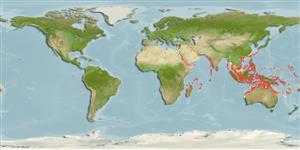Common names from other countries
Environment: milieu / climate zone / depth range / distribution range
Ekologi
Berasosiasi dengan karang; kisaran kedalaman 3 - 56 m (Ref. 8294). Tropical; 30°N - 27°S, 32°E - 172°W (Ref. 848)
Indo-West Pacific: Bonin Islands to Australia and Red Sea to Kiribati.
Length at first maturity / Size / Weight / umur
Maturity: Lm ? range ? - ? cm
Maximum depth from Ref. 100940.
Life cycle and mating behavior
Kematangan | Reproduksi, perkembang biakan | Pemijahan | telur-telur | Fecundity | Larva
Mature gametes are shed into the coelenteron and spawned through the mouth. Life cycle: The zygote develops into a planktonic planula larva. Metamorphosis begins with early morphogenesis of tentacles, septa and pharynx before larval settlement on the aboral end (Ref. 833).
rujukan utama
Acuan | Koordinator | mitra
Ross, M.A. and G. Hodgson. 1981. (Ref. 8294)
Status IUCN Red List (Ref. 130435: Version 2024-1)
status CITES (Ref. 108899)
Not Evaluated
penggunaan manusia
| FishSource |
Alat, peralatan
informasi lanjut
Umur / SaizPertumbuhanpanjang-beratpanjang-panjangMorfologiLarvaKelimpahan
Sumber internet
Estimates based on models
Preferred temperature
(Ref.
115969): 25.4 - 29.3, mean 28.5 (based on 3105 cells).
kategori harga
Unknown.
